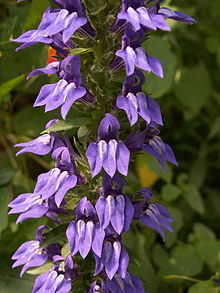
Gynodioecy is a rare breeding system that is found in certain flowering plant species in which female and hermaphroditic plants coexist within a population. Gynodioecy is the evolutionary intermediate between hermaphroditism (exhibiting both female and male parts) and dioecy (having two distinct morphs: male and female).
Gynodioecy is sometimes considered a mixed mating systems comparable with trioecy and androdioecy.[1] It is also considered a dimorphic sexual system alongside dioecy and androdioecy.[2]
Gynodioecy occurs as a result of a genetic mutation that inhibits a hermaphroditic plant from producing pollen, while keeping the female reproductive parts intact. Gynodioecy is extremely rare, with fewer than 1% of angiosperm species exhibiting the breeding system. Some notable taxa that exhibit a gynodioecious mating system include Beta vulgaris (wild beet), Lobelia siphilitica, Silene, and Lamiaceae.
- ^ Fusco G, Minelli A (2019-10-10). The Biology of Reproduction. Cambridge University Press. p. 134. ISBN 978-1-108-49985-9.
- ^ Torices, Rubén; Méndez, Marcos; Gómez, José María (2011). "Where do monomorphic sexual systems fit in the evolution of dioecy? Insights from the largest family of angiosperms". New Phytologist. 190 (1): 234–248. doi:10.1111/j.1469-8137.2010.03609.x. ISSN 1469-8137. PMID 21219336.
© MMXXIII Rich X Search. We shall prevail. All rights reserved. Rich X Search
